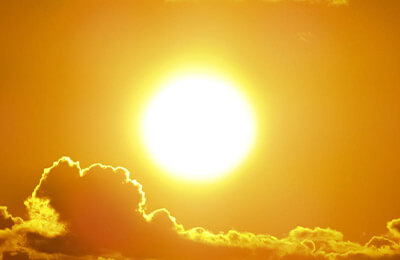体验太阳系行星气候之极
时间:2022-10-12 10:14:39

Earth has terrible weather. Winds can blow you off a mountain top or rip[撕裂] the roof off your house. In some places, it rains so hard that you could drown. Some places get hot enough to fry your breakfast eggs on a rock…or cold enough to freeze the tears on your eyelashes[睫毛].
So, where else could we go in our solar system to have a nice vacation away from this wild Earth
weather?
Extremely Hot Venus[金星]
The hottest day that we know of on Earth was July 10th, 1913. On that day, Death Valley, California, reached 134. But compared
to Venus, that temperature is a cool breeze[微风]. The thick atmosphere[大气(层)]
of carbon dioxide[二氧化碳] on
Venus turns it into a greenhouse. The
atmosphere holds in the Sun’s heat and never lets the planet cool off, even at night. Surface
temperatures are almost 900- hot enough to melt lead[铅]!
As a vacation spot, Venus is definitely out.
So, where shall we go to cool off?
A Refreshing Mars Stop
How about Mars? It’s farther from the Sun than Earth is, and the air is very thin. So it will be cool and refreshing like on a mountain top, right?
Wrong!
Yes, it’s cool. The daytime, the temperature gets all the way up to 80. But at night, the temperature can drop to almost -200! On Mars, this sort of weather occurs all the time, swinging[摇摆]
from warmest to
coldest in one day!
Why such wild swings? The air (if you could call it that) on Mars is made mostly of carbon dioxide. But the air is so thin (less than 1/100 as thick as Earth’s air) that the heat from the daytime Sun escapes into space at night. This thin air can still kick up a huge dust storm. The whole planet can be wrapped[包起来]
in clouds of Martian[火星的] dust for weeks at a time. In calmer times, whirly[旋转的] winds stir up[搅起] the soil, making “dust devils[小风暴,尘卷]” that dance across the Martian surface.
So, Mars’ weather isn’t much fun either.
Skating Anyone?
If you’re going to be cold anyway, you can at least go somewhere with winter sporting opportunities. If you ice skate, how about Europa[木卫二]? Europa is one of the four largest moons of Jupiter[木星]. It’s
a little smaller than Earth’s Moon, but it’s covered in ice - smooth ice! Its gravity is only about 1/8 of Earth’s, so imagine
the height you could get on a triple
axel[(花样滑冰)一周半跳]!
Unfortunately, with Europa temperatures around -328, you would be frozen hard as a rock in a nanosecond[十亿分之一秒].
Well, our search for better weather in the
solar system isn’t looking
promising[有希望的].
A Long Hurricane Season
Perhaps you’ve always wondered what it would be like to be inside a hurricane. On Earth, the strongest ever recorded hurricane winds blew at around 200 miles per hour. Well, Jupiter’s Great Red Spot注 would give you a whirlwind[旋风]
ride like you would never find on Earth. Counter-
clockwise[反时针方向] winds of about 250 miles per hour blow clouds high in Jupiter’s atmosphere into a beautiful, swirling pattern. The Red Spot could swallow up two whole Earths. This storm has been raging[狂吹] for at least 300 years!
But even 250 miles per hour is a gentle breeze compared to our next stop.
Breezy - but Beautiful!
Saturn[土星] is so beautiful from Earth with its lovely rings and bands of clouds. Those clouds are moving at
different speeds - of around 1,100 miles per hour! Some blow
eastward, some blow westward. Oh, and it’s cold on Saturn too, although not quite as cold as Europa. Then there’s the small problem that it’s a gas giant, so there’s no solid ground to stand upon.
Land of Lakes
Now Saturn’s moon Titan[土卫六], at first glance, looks promising. It’s the second largest moon in the solar system. Titan is covered in thick, hazy[雾蒙蒙的] clouds. So, does it rain on Titan? Let’s dive under the clouds and see. Oh, look - lakes! Liquid lakes! Does that mean it’s
warm enough for water to be a liquid? Alas, no. The lakes are filled not with water, but with liquid methane[甲烷] or ethane[乙烷].
We have methane here on Earth too, but as a gas - sometimes known as marsh gas[沼气]. To “freeze” into a liquid and rain out of the clouds on Titan, the methane must be colder than -296.5.
Oops! Clouds, rain, and pretty lakes are no
guarantee[保证] of a friendly, Earth-like environment.
So let’s keep going.
The Windiest
We’ll just skip Uranus[天王星], because it’s
another really windy gas giant. Neptune[海王星]’s winds are the fastest in the solar system, reaching 1,600 miles per hour! Neptune has been known to have giant, spinning storms that could swallow the whole Earth.
The Iciest
One of Neptune’s moons, Triton[海卫一], might be worth checking out. At least it’s solid and it has an atmosphere - barely. And its atmosphere even has something in common
with Earth’s. It is mostly
nitrogen[氮]. Triton’s unique ice
volcanoes[火山] might make it a fascinating tourist stop. However, with a surface
temperature of -391, this moon is one of the coldest
objects in the solar system!
Let’s Go Home!
Well, Earth is starting to look like an ideal vacation
spot, in spite of its “wild weather.” Earth isn’t the only planet with weather, but it’s by far got the best.
地球的气候太可怕了。风大得可以把你从山顶刮下来,还可以掀起你的屋顶。在一些地方,雨大得可以把人淹死。有些地方热得可以在石头上煎早餐蛋……而有些地方则冷得能把睫毛上的泪水化成冰晶。
那么,茫茫太阳系之中,我们还能去何处躲避地球恶劣的气候,寻找一处度假胜地呢?
超级火球金星
我们已知地球上最热的一天是1913年7月10日。那一天,(美国)加利福尼亚州的死亡谷气温高达134(56.6℃)。但这样的温度在金星上只能算是凉风一缕。金星上厚厚的二氧化碳大气层把这颗星球变成了一个温室。大气层锁住太阳的热量,使星球即使在夜里也凉快不下来。金星表面温度约有900(482.2℃)――热得足以使铅
熔化!
因此,以一个度假胜地而言,金星肯定
落选。
那么,我们该去哪里凉快一下呢?
清新火星休憩站
火星如何?它与太阳的距离比地球远,而且大气稀薄。那么火星一定会像在山顶般清爽怡人,对吧?
错!
没错,火星确实很凉爽,白天气温最高只有80
(26.6℃)。
但到了晚上,气温可跌至-200(-128.8℃)!在火星上,这种昼夜温差极大的天气是常事,同一天里的温度可由最热跌至最冷!
为什么火星气温落差如此之大呢?火星上的空气(假如我们可以这样叫它的话)主要由二氧化碳构成。然而其大气是如此之薄(厚度不及地球大气层的百分之一),以致白天从太阳吸收的热量都在夜里散发殆尽。这么薄的大气层还能引起巨大的尘暴。每次火星刮起尘暴,整个星球可能持续数周都被包裹在烟尘中。在稍为平静的天气里,旋转的风会卷起沙土,刮起“小风暴”,在火星表面各处旋舞。
这么看来,火星的天气也不怎么好玩。
有人要溜冰吗?
要是无论去哪儿都躲不开寒冷的话,那么至少去一个能提供冬季运动机会的地方。如果你溜冰,不妨考虑一下木卫二。木卫二是木星四大卫星之一,体积略小于地球的卫星月球,但表面被冰所覆盖――还是光滑的冰层呢!其重力大约只有地球的1/8,所以,想象一下你做一个三周半跳将是什么情景!不幸的是,在木卫二仅有-328(-200℃)的气温之下,只消十亿分之一秒,你就会被冻成一块坚硬的石头。
看来,我们在太阳系寻找更怡人天气的努力前景不太明朗啊。
漫漫飓风季
也许你一直想知道置身飓风之中是怎样一种感觉。在地球上,有记载的最强飓风风力达到每小时200英里(321.7千米)。然而,木星上的“大红斑”能让你体验在地球上所感受不到的飓风之旅。时速达250英里(402.3千米)、逆时针方向的风将木星大气层高空的云吹成美丽的旋涡状。大红斑能把整整两个地球吞没,而且这个风暴至少已经在木星上肆虐了三百年!
然而跟我们的下一站比起来,250英里的时速不过是一阵微风罢了。
风速美丽
从地球上看,拥有美丽圆环和云带的土星显得如此迷人。这些云以不同的速度移动――时速约1100英里(1770.3千米)!有的向东,有的向西。噢,土星也很冷,虽然不及木卫二冷。此外,还有一个小小的问题――土星是一个气体巨人,它没有坚实的地面可供立足。
千湖之地
乍看之下,土星的卫星土卫六似乎还能带给我们一丝希望。土卫六是太阳系第二大卫星,上面覆盖着烟雾弥漫的厚云。那么,这里是不是会下雨呢?让我们潜到云层底下看看吧。噢,看――湖!液态湖!这是否意味着这里暖和得足以让水以液态的形式存在呢?唉,不是的。湖里的液体并非水,而是甲烷或
乙烷。
我们的地球上也有甲烷,但它呈气态――有时候也称作沼气。在土卫六上,要使甲烷“冻”成液态并形成降雨,温度必须低于-296.5(-182.5℃)。哎呀!这么说,云、雨和漂亮的湖泊也不能保证这里就有像地球那么友善的环境呢。
那么我们继续寻找吧。
大风吹
我们就直接跳过天王星好了,因为它又是一个狂风肆虐的气体巨人。海王星的风速是整个太阳系里最快的,达到1600英里/小时(2575.0千米/小时)!据悉,海王星上有巨大的旋风,足以把整个地球吞没。
千里冰封
海王星的其中一个卫星海卫一可能值得一探。起码它是个固体星球,又有大气层――虽然很稀薄。其大气层与地球大气甚至还有某些相似之处,主要由氮气构成。海卫一上独特的冰火山亦使之成为极具吸引力的旅游站点。然而,这颗卫星的表面温度低至-391(-235℃),是太阳系里最冷的天体
之一。
我们还是回家吧!
看来,还是地球更像一个理想的度假胜地,即使它“气候恶劣”。地球并非唯一有天气变化的星球,但到目前为止,它的气象最为
怡人。
注:木星大红斑是一团激烈的沿逆时针方向运动的上升气流。它是一块蛋形的斑块,由玫瑰色、棕色和白色的云层组成。观测结果表明,这个大红斑长达2万千米,宽约1.1万千米。